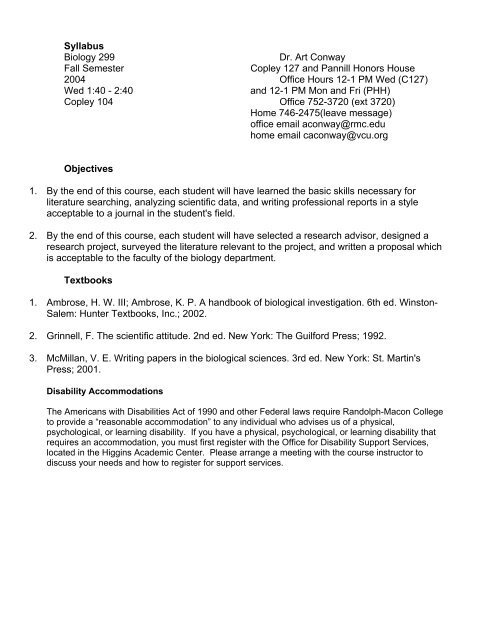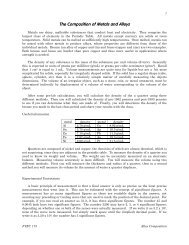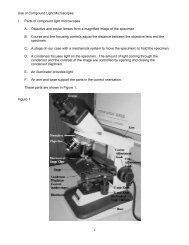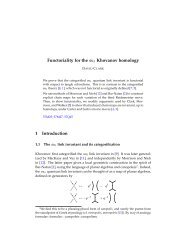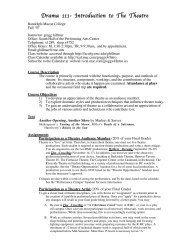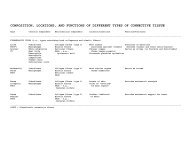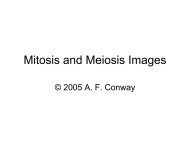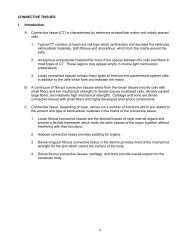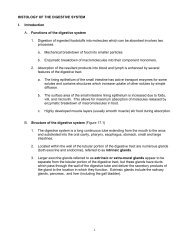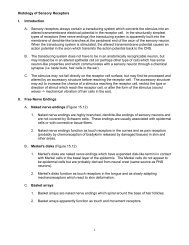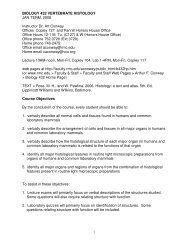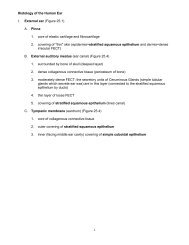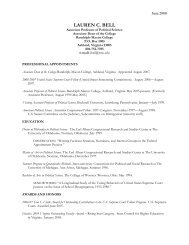Syllabus Biology 299 Dr. Art Conway Fall ... - Faculty.rmc.edu
Syllabus Biology 299 Dr. Art Conway Fall ... - Faculty.rmc.edu
Syllabus Biology 299 Dr. Art Conway Fall ... - Faculty.rmc.edu
Create successful ePaper yourself
Turn your PDF publications into a flip-book with our unique Google optimized e-Paper software.
<strong>Syllabus</strong><br />
<strong>Biology</strong> <strong>299</strong><br />
<strong>Dr</strong>. <strong>Art</strong> <strong>Conway</strong><br />
<strong>Fall</strong> Semester<br />
Copley 127 and Pannill Honors House<br />
2004 Office Hours 12-1 PM Wed (C127)<br />
Wed 1:40 - 2:40<br />
and 12-1 PM Mon and Fri (PHH)<br />
Copley 104 Office 752-3720 (ext 3720)<br />
Home 746-2475(leave message)<br />
office email aconway@<strong>rmc</strong>.<strong>edu</strong><br />
home email caconway@vcu.org<br />
Objectives<br />
1. By the end of this course, each student will have learned the basic skills necessary for<br />
literature searching, analyzing scientific data, and writing professional reports in a style<br />
acceptable to a journal in the student's field.<br />
2. By the end of this course, each student will have selected a research advisor, designed a<br />
research project, surveyed the literature relevant to the project, and written a proposal which<br />
is acceptable to the faculty of the biology department.<br />
Textbooks<br />
1. Ambrose, H. W. III; Ambrose, K. P. A handbook of biological investigation. 6th ed. Winston-<br />
Salem: Hunter Textbooks, Inc.; 2002.<br />
2. Grinnell, F. The scientific attitude. 2nd ed. New York: The Guilford Press; 1992.<br />
3. McMillan, V. E. Writing papers in the biological sciences. 3rd ed. New York: St. Martin's<br />
Press; 2001.<br />
Disability Accommodations<br />
The Americans with Disabilities Act of 1990 and other Federal laws require Randolph-Macon College<br />
to provide a “reasonable accommodation” to any individual who advises us of a physical,<br />
psychological, or learning disability. If you have a physical, psychological, or learning disability that<br />
requires an accommodation, you must first register with the Office for Disability Support Services,<br />
located in the Higgins Academic Center. Please arrange a meeting with the course instructor to<br />
discuss your needs and how to register for support services.
Class Sch<strong>edu</strong>le<br />
Date Session Assignment<br />
Sept 8<br />
Overview of the course<br />
15 What is research? Read A&A Ch 1,2<br />
Designing a research project G Intro, Chs 1-4,7,8<br />
McM Intro, Ch 2<br />
Exercise 1 handouts<br />
Hand in Ex 1<br />
22 Library research techniques Read library<br />
research handouts,<br />
A&A Chs 9-10<br />
McM Ch 1<br />
Hand in Ex 2<br />
29 Ethics in research Read G Chs 5,6<br />
Hand in Ex 3<br />
Oct 6 Research project design Read A&A Chs 1,6<br />
McM Ch 2<br />
Hand in Ex 4<br />
13 The Title, Introduction, Read McM Chs1, 4-6<br />
Materials and Methods A&A Chs 9-11,13<br />
Literature Cited Hand in Ex 5<br />
20 Data analysis Read A&A Chs 2-8<br />
(discuss Ex 5) McM Ch 2<br />
Hand in Ex 6<br />
27 The Results Section Read McM Chs 1, 3, 4<br />
(discuss Ex 6) A&A Chs 10-13<br />
Hand in Ex 7<br />
Nov 3 Discussion Section Read McM Ch 1, 4<br />
(discuss Ex 7) A&A Chs 10-11,13<br />
Hand in Ex 8<br />
10 The Abstract Read McM Ch 4, 10<br />
Verbal presentation A&A Chs 10-13<br />
techniques<br />
Hand in Ex 9 and<br />
(discuss Ex 8)<br />
rough draft of<br />
entire proposal<br />
17 Student presentations<br />
24 Thanksgiving Break<br />
Dec 1 Student presentations<br />
10 Proposals are due in <strong>Dr</strong>. Martin's office by 5 PM
Requirements for <strong>Biology</strong> <strong>299</strong><br />
1. Each student must attend all weekly meetings of <strong>Biology</strong> <strong>299</strong> (unless excused by the<br />
Instructor(s)) and participate fully in class discussions of readings and exercises.<br />
2. Each student must submit all of the written exercises assigned during Biol. <strong>299</strong>. These will be<br />
graded by the instructor(s).<br />
3. Each student must select a Research Advisor who is a faculty member in the <strong>Biology</strong><br />
Department. The student should select his or her Research Advisor during the first three weeks<br />
of the semester in which <strong>Biology</strong> <strong>299</strong> is taken and must meet regularly with the Research Advisor<br />
while designing the student's research project and writing the formal research proposal. The<br />
student must give the RESEARCH ADVISOR'S EVALUATION form at the end of this document<br />
to the Research Advisor when the Advisor is chosen.<br />
4. Each student must prepare a formal research proposal for the project which the student plans to<br />
do in <strong>Biology</strong> 300 or <strong>Biology</strong> 497-498 or <strong>Biology</strong> 487-488. This paper must follow typical<br />
guidelines for preparation of proposals for research (the format is appended). The paper must be<br />
completed and turned in to the departmental office by 5 P.M. of the last day of regular classes in<br />
the semester in which Biol. <strong>299</strong> is taken. The APPLICATION FOR ADMISSION TO A BIOLOGY<br />
RESEARCH COURSE form at the end of this document must be the first page on the proposal.<br />
5. Each student must prepare and present a seminar describing his/her proposed project. This will<br />
be presented to the <strong>Biology</strong> <strong>299</strong> class during the last 2 weeks of the semester.<br />
6. Each student must attend all seminar presentations by students in biology research courses (Biol<br />
300, 488, 498) which are given during the semester the student is registered for <strong>Biology</strong> <strong>299</strong>.<br />
Students with classes which conflict with seminar presentations will be excused from those<br />
seminars but must notify the instructor(s) in charge of <strong>Biology</strong> <strong>299</strong> in writing.<br />
7. Any student who wishes to do an off-campus project must submit the APPLICATION TO DO AN<br />
OFF-CAMPUS BIOLOGY RESEARCH COURSE (appended to this document) to the<br />
Chairperson of the <strong>Biology</strong> Department no later than the ninth week of the semester prior to the<br />
semester in which the project will be done.
Major Assignments In <strong>Biology</strong> <strong>299</strong><br />
1. Choose a research project and a Research Advisor.<br />
This should be done within the first 2 weeks of classes. Students should begin talking to faculty<br />
immediately and should choose a Research Advisor by the end of the third week of classes.<br />
<strong>Biology</strong> <strong>299</strong> is designed to help students design a research project which can be done in a 1 or 2<br />
semester period. The full benefit of this course will not be realized unless the project is designed<br />
as the course progresses. Our experience has been that students who wait until late in the<br />
course to choose a project usually end up with a poor literature search, a poorly designed project,<br />
and a poorly written proposal. These problems can be eliminated by deciding on a project at the<br />
start of the semester and then refining the design of the project as the semester progresses. This<br />
should also eliminate a time crunch at the end of the semester.<br />
2. Do a complete literature search on the project area.<br />
A complete literature search should consist primarily of references to original scientific journal<br />
articles, with a few other general references as needed. A typical literature search should include<br />
from 25 to several hundred journal articles. The criterion used to judge the literature search is its<br />
completeness, not the total number. References on organisms similar to the species which will<br />
be used in the project should be included, and references to similar biological phenomena in<br />
unrelated organisms may also be useful. The literature search should be completed by<br />
midsemester or shortly thereafter to allow sufficient time for writing a proposal.<br />
3. Write a formal research proposal for submission to the biology department.<br />
This proposal will be evaluated by the department as part of the student's grade in <strong>299</strong>, but<br />
presentation of an acceptable proposal to the department is also one of the prerequisites for<br />
enrollment in <strong>Biology</strong> 300, 487-488, or 497-498. Students who fail to provide a proposal which<br />
the department approves will not be allowed to take a research course until an acceptable<br />
proposal is submitted.<br />
The student should submit preliminary drafts of the proposal to the Research Advisor and to other<br />
faculty members for comments. At least 1 week should be allowed for each rough draft<br />
submission. The extent and the usefulness of the faculty comments will be increased if the<br />
student produces a well organized paper before submitting it for comments. The usefulness of<br />
faculty comments is also increased if the faculty member is allowed adequate time to read the<br />
paper numerous times.
Grading<br />
1. Weekly Seminar Grade - 60% of final grade<br />
Homework exercises will be graded, and those grades will be averaged at the end of the<br />
semester. The Research Advisor's grade is averaged with the exercises. The mean exercise<br />
grade adjusted for attendance becomes the seminar grade.<br />
Attendance is required at all classes in Biol. <strong>299</strong>. Absences approved by the instructor are not<br />
counted when computing attendance. Each unapproved absence will lower the weekly seminar<br />
grade 5%.<br />
Class participation will be used to determine the letter grade for any student whose course<br />
grade falls within 0.5% of a letter grade boundary. Above average participation will raise the<br />
course grade by up to 0.5%, average participation will cause no change in the grade, and below<br />
average participation will lower the course grade by up to 0.5%.<br />
2. Formal Proposal - 40% of final grade<br />
The proposal will be graded by the <strong>Biology</strong> Department faculty. Each faculty member assigns a<br />
grade to the proposal and these grades are then averaged to produce the paper grade. The<br />
paper grade will be lowered by 1 letter grade (10%) for every calendar day (or part of a day) that<br />
it is late. The paper grade will also be lowered if the required format for the proposal is not<br />
followed exactly.<br />
3. Final Grade<br />
Final grades will be assigned using the following scale.<br />
100 - 97.0% = A+<br />
96.99 - 93.0% = A<br />
92.99 - 90.0% = A-<br />
89.99 - 87.0% = B+<br />
86.99 - 83.0% = B<br />
82.99 - 80.0% = B-<br />
79.99 - 77.0% = C+<br />
76.99 - 73.0% = C<br />
72.99 - 70.0% = C-<br />
69.99 - 67.0% = D+<br />
66.99 - 63.0% = D<br />
62.99 - 60.0% = D-<br />
The Written Proposal<br />
1. The paper should be written in a style acceptable to a granting agency in the area of research.<br />
Unless permission is granted by the instructor(s)of <strong>Biology</strong> <strong>299</strong> and the student's Research<br />
Advisor, the proposal must follow the format below. The format follows the recommendations of<br />
the CBE Style Manual (1).<br />
2. The paper must be typed and double spaced.<br />
3. Each section must begin on a new page.<br />
4. The title page must be the APPLICATION FOR ADMISSION TO A BIOLOGY RESEARCH<br />
COURSE form which is appended to this document.<br />
Introduction<br />
1. Survey the existing knowledge which pertains to your proposed project. This means finding more<br />
than 1 or 2 review articles. You are expected to thoroughly review all of the past literature.<br />
Effective strategies will be covered in class.<br />
2. Describe what your project is designed to determine and why it is meaningful (i.e. why should you<br />
do it?). The objective(s) of the project must be VERY clearly stated in the form of information to<br />
be obtained or hypotheses to be tested.<br />
3. Use present tense for information which extends beyond a single reported experiment.<br />
4. Use past tense to refer to results of specific previous experiments.<br />
5. Use future tense to refer to your proposed work.<br />
Materials and Methods<br />
1. Describe what you plan to do in enough detail to allow evaluation of the effectiveness and<br />
practicality of the experimental design and the proposed methods. Published methods which will<br />
be followed exactly may be cited without describing them.<br />
2. Any modifications of published methods or new methods must be described fully.<br />
3. Use future tense.<br />
Project Budget<br />
1. This section should consist of a listing of the supplies and materials needed for the project. The<br />
listing should include the approximate cost of each major item and the suggested source for each<br />
unusual item.<br />
2. Field projects must include an estimate of total vehicle mileage which will be needed for collecting<br />
trips, etc. during the study.<br />
3. This section may be organized as a table.
Expected Results and Interpretation<br />
1. Verbally describe all important expected results. You will probably have to base this on previous<br />
studies on related organisms or on extrapolations from the current information using accepted<br />
theories. You may find that there are several alternative possibilities. You should not get too "far<br />
afield" in this section, but you must show that you understand the current status of the field and<br />
that you have thought through the reasonable possibilities in terms of results.<br />
2. Indicate clearly how the results will be analyzed. Be sure to include the statistical methods to be<br />
used.<br />
3. Explain why the information which you expect to obtain will be important to the area of biology<br />
related to your research.<br />
Literature Cited<br />
1. Include only references actually cited in the text of the paper.<br />
2. All items of information which are not results of the current study should be referenced as to<br />
source in the text of the paper.<br />
3. A typical <strong>Biology</strong> <strong>299</strong> proposal should contain 25 to 100 references.<br />
4. DO NOT USE FOOT-NOTES EXCEPT TO DEFINE ABBREVIATIONS!<br />
5. Acceptable formats for citations in the text of the paper are Author (#) and (#).<br />
6. References in the Literature Cited section must be arranged alphabetically and numbered<br />
sequentially. These numbers are used in the text to refer to the references. Consult the CBE<br />
Style Manual (1) for detailed examples of Literature Cited entries. A few selected examples are<br />
shown below.<br />
Literature Cited<br />
1. CBE Style Manual Committee. CBE style manual. 5th ed. Bethesda: Council of <strong>Biology</strong> Editors;<br />
1983.<br />
2. Caulfield, M. J.; Shaffer, D. A computer program for evaluation of ELISA data obtained using an<br />
automated microtiter plate absorbance reader. J. Immunol. Methods 74:205-215; 1984.<br />
3. Gardner, R. Origins and properties of trophoblast. In: Edwards, R. G.; Howe, C. W. S.; Johnson,<br />
M. H., eds. Immunology of trophoblast. Cambridge: Cambridge University Press, 1975:43-65.
Figures<br />
1. Photographs, drawings, and graphs should be located in the Figures section of the paper.<br />
2. The Figures section of the paper should follow the Literature Cited section in the paper.<br />
3. Each figure should be numbered with an Arabic numeral (1,2,3 etc.). Letters (a, b, c, etc.) may<br />
be used to indicate parts of a multi-part figure.<br />
4. The figures should be numbered in the order in which they are first referred to in the text of the<br />
paper.<br />
5. More than 1 figure may be placed on a page, but each page of figures MUST have margins of at<br />
least 1 inch on the free sides of the page and 1.5 inches on the binding side of the page.<br />
6. Photographs or drawings should be done to professional standards and clearly labeled.<br />
7. Graphs should be done with professional materials (computer printer, black ink, tape, etc.) on<br />
plain white paper.<br />
8. A page of corresponding Figure Legends must be bound facing each page of figures.<br />
9. Each Figure Legend must include the figure title and a brief description of the figure. When<br />
appropriate, the figure legend should also include a list of abbreviations used in the figure,<br />
probability values and the name of the test used to generate them, magnification of photographs,<br />
and any other useful information. The reader should be able to interpret the figure using only the<br />
Figure Legend plus the Materials and Methods section of the paper.<br />
Tables<br />
1. Tables should be placed in a separate Tables section which should follow the Figures section.<br />
2. Tables should be numbered with Roman numerals (I, II, III, etc.) in the order in which they are<br />
first referred to in the text of the paper.<br />
3. More than 1 table may be placed on a page, but each page of tables must have margins of at<br />
least 1 inch on all free sides and 1.5 inches on the bound side.<br />
4. Tables must be typed or lettered on plain white paper.<br />
5. Each page of tables must be accompanied by a facing page of Table Legends.<br />
6. Each Table Legend must give the full title of the table, give a brief description of the table, and<br />
define any abbreviations used. The reader should be able to interpret the table using only the<br />
Table Legend plus the Materials and Methods section of the paper.
The Oral Presentation in <strong>Biology</strong> <strong>299</strong><br />
1. Your oral presentation will be made to the <strong>Biology</strong> <strong>299</strong> class. You will have 5 minutes for your<br />
oral presentation which will be followed by about 3 minutes of questions from the audience. This<br />
is a shortened form of the format followed at most professional meetings in biology.<br />
2. The oral presentation should follow the same basic format as the written proposal (see below).<br />
3. All information should be presented in a logical sequence.<br />
4. The oral presentation should include effective visual aids. Effective visual aids display data<br />
patterns in easily understood ways and contain text which is large enough to be easily read from<br />
the rear of the room. Refer back to the materials covering design of graphs and tables.<br />
5. The oral presentation should be prepared in advance and practiced numerous times. Several of<br />
those practice presentations should be made to your research advisor so that you can benefit<br />
from his or her suggestions.<br />
6. You should be able to give your talk with no more than occasional references to notes. You<br />
should attempt to maintain good eye contact with the audience and should point out items on<br />
your visual aids as you refer to them.<br />
7. You should speak distinctly at a volume which can be easily heard at the rear of the room.<br />
8. You should pace your talk so that you can comfortably complete it in the allotted 5 minutes<br />
without rushing.<br />
Title of the oral presentation<br />
The title of the oral presentation should be the same as the title of the written proposal and should<br />
allow a reader to determine what you propose to do in your experiment.<br />
Introduction section of the oral presentation<br />
1. Briefly summarize the existing knowledge which pertains to your project. This summary should<br />
allow a general scientific audience to understand the reasoning behind your research project.<br />
2. Use present tense for information which extends beyond a single reported experiment. Use past<br />
tense to refer to results of specific previous experiments.<br />
3. Clearly state the question or questions which your project is designed to answer.<br />
4. Describe why your project is meaningful.
Materials and methods section of the oral presentation<br />
1. Use future tense.<br />
2. Summarize the methods which will be used, ideally using a flow diagram. Do not recite detailed<br />
methods unless they are absolutely essential to the interpretation of your results. Be prepared to<br />
describe details of methods if questions arise in the question and answer period after your talk.<br />
Expected Results and Interpretation section of the oral presentation<br />
1. Use future tense.<br />
2. Verbally summarize each of the important expected pattern(s) and indicate how these patterns<br />
will be statistically analyzed.<br />
Questions following the oral presentation<br />
1. During the 3 minute question period after your oral presentation you should be prepared to deal<br />
with questions about any aspect of your proposed research project and its implications.<br />
2. Be sure that you understand the question before attempting to answer.<br />
3. Clearly distinguish between the parts of your answer that you are reasonably certain are accurate<br />
and the parts of which are less certain. If you are unsure of the answer to a question, be honest<br />
about your uncertainty. Honest uncertainty is generally viewed much more charitably that an<br />
answer stated with great certainty which turns out to be incorrect.
Paper Format Evaluation Form (This copy is for student's reference)<br />
Student Name _________________________________________<br />
Course ______________<br />
Proper sections present in paper ?<br />
All sections of paper properly formatted ?<br />
Proper reference style in text of paper ?<br />
Proper reference style in Literature Cited ?<br />
Literature Cited references all used in the text ?<br />
Citations in the text all included in Literature Cited ?<br />
Figures and tables properly done ?<br />
Figure and table legends properly done ?<br />
Other problems ?<br />
Total Paper Grade R<strong>edu</strong>ction<br />
(1 letter grade maximum)<br />
_______________________
Evaluation of Biol <strong>299</strong> Oral Presentation(This copy is for student's reference)<br />
Student ______________________________________<br />
____ / 2 Effective communication of background information<br />
____ / 2 Effective statement of the question<br />
____ / 2 Effective communication of the proposed methods<br />
____ / 1 Effective communication of the analysis to be applied to the results<br />
____ / 1 Effective delivery (clarity of speaking, physical presence)<br />
____ / 2 Effective organization of the talk<br />
_____ / 10 Total score
RESEARCH ADVISOR'S EVALUATION (Student's reference copy)<br />
This form must be given to the Research Advisor as soon as the student selects the Research<br />
Advisor. The Research Advisor will give the form to the <strong>Biology</strong> <strong>299</strong> Instructor at the end of the<br />
semester. The form will be graded by the Instructor and will constitute a potential 40 points in the<br />
Weekly Seminar Grade in <strong>Biology</strong> <strong>299</strong>.<br />
STUDENT'S NAME<br />
_________________________________________________________<br />
The student gave me this form<br />
The student<br />
during during during during during failed<br />
the the the the the to give<br />
first second third fourth last this form<br />
3 weeks 3 weeks 3 weeks 3 weeks week to me.<br />
of the semester.<br />
(10 pts) (8 pts) (6 pts) (4 pts) (2 pts) (0 pts)<br />
(Please mark one space)<br />
The student made and kept<br />
10-13 7 - 9 5 - 6 3 - 4 1 - 2 0<br />
appointments with me during the semester.<br />
(10 pts) (8 pts) (6 pts) (4 pts) (2 pts) (0 pts)<br />
(Please mark one space)<br />
The student's library research was<br />
complete minimal not<br />
and and done.<br />
timely.<br />
late.<br />
(10 pts) (8 pts) (6 pts) (4 pts) (2 pts) (0 pts)<br />
(Please mark one space)<br />
The student submitted<br />
numerous one no<br />
high<br />
poor<br />
quality<br />
quality<br />
rough drafts of the proposal for my comments.<br />
(10 pts) (8 pts) (6 pts) (4 pts) (2 pts) (0 pts)<br />
(Please mark one space)<br />
_______________________________________________<br />
Research Advisor's Signature
APPLICATION FOR ADMISSION TO A BIOLOGY RESEARCH COURSE<br />
This form must be the front page of all proposals when they are turned in to <strong>Dr</strong>. Martin.<br />
NAME<br />
_________________________________________________________<br />
TITLE OF PROJECT<br />
_____________________________________________________________<br />
_____________________________________________________________<br />
_____________________________________________________________<br />
TYPE OF PROJECT<br />
LIBRARY PROJECT____<br />
FIELD or LABORATORY PROJECT____<br />
OFF-CAMPUS PROJECT ____<br />
COURSE WHICH WILL BE TAKEN<br />
<strong>Biology</strong> 300 ____ (Topics in <strong>Biology</strong>)<br />
<strong>Biology</strong> 487-488 ____ (Departmental Honors in <strong>Biology</strong>)<br />
[Open only to Honors Program students]<br />
<strong>Biology</strong> 497-498 ____ (Senior Project)<br />
SEMESTER(S) IN WHICH PROJECT WILL BE DONE<br />
<strong>Fall</strong>____ Spring____<br />
YEAR(S) IN WHICH PROJECT WILL BE DONE<br />
20____<br />
PROJECT ADVISOR'S SIGNATURE _________________________________
APPLICATION TO DO AN OFF-CAMPUS BIOLOGY RESEARCH PROJECT<br />
This form must be submitted to the Chairperson of the <strong>Biology</strong> Department no later than the ninth<br />
week of the semester prior to the semester in which the project will be done.<br />
NAME<br />
_________________________________________________________<br />
TITLE OF PROJECT<br />
_____________________________________________________________<br />
_____________________________________________________________<br />
_____________________________________________________________<br />
LOCATION OF PROJECT<br />
______________________________________________________________<br />
______________________________________________________________<br />
______________________________________________________________<br />
COURSE(S) WHICH WILL BE TAKEN<br />
<strong>Biology</strong> 300<br />
____ (Topics in <strong>Biology</strong>)<br />
<strong>Biology</strong> 487-488 ____ (Departmental Honors in <strong>Biology</strong>)<br />
[Open only to Honors Program students]<br />
<strong>Biology</strong> 497-498 ____ (Senior Project)<br />
SEMESTER(S) AND YEAR(S) IN WHICH YOU WILL REGISTER FOR THIS(THESE) COURSE(S)<br />
Summer____ <strong>Fall</strong>____ Jan____ Spring____<br />
20____<br />
SEMESTER(S) AND YEAR(S) IN WHICH THE PROJECT WORK WILL BE DONE<br />
Summer____ <strong>Fall</strong>____ Jan____ Spring____<br />
20____<br />
PROJECT ADVISORS' SIGNATURES<br />
On-campus _________________________________<br />
Off-campus _________________________________<br />
REASONS FOR DOING AN OFF-CAMPUS PROJECT<br />
Attach a typed justification which explains<br />
1. Why you want to do the project off-campus<br />
2. What resources will be provided by the host location<br />
3. What resources must be provided by Randolph-Macon
RESEARCH ADVISOR'S EVALUATION<br />
This form must be given to the Research Advisor as soon as the student selects the Research<br />
Advisor. The Research Advisor will give the form to the <strong>Biology</strong> <strong>299</strong> Instructor at the end of the<br />
semester. The form will be graded by the Instructor and will constitute a potential 40 points in the<br />
Weekly Seminar Grade in <strong>Biology</strong> <strong>299</strong>.<br />
STUDENT'S NAME<br />
_________________________________________________________<br />
The student gave me this form<br />
The student<br />
during during during during during failed<br />
the the the the the to give<br />
first second third fourth last this form<br />
3 weeks 3 weeks 3 weeks 3 weeks week to me.<br />
of the semester.<br />
(10 pts) (8 pts) (6 pts) (4 pts) (2 pts) (0 pts)<br />
(Please mark one space)<br />
The student made and kept<br />
10-13 7 - 9 5 - 6 3 - 4 1 - 2 0<br />
appointments with me during the semester.<br />
(10 pts) (8 pts) (6 pts) (4 pts) (2 pts) (0 pts)<br />
(Please mark one space)<br />
The student's library research was<br />
complete minimal not<br />
and and done.<br />
timely.<br />
late.<br />
(10 pts) (8 pts) (6 pts) (4 pts) (2 pts) (0 pts)<br />
(Please mark one space)<br />
The student submitted<br />
numerous one no<br />
high<br />
poor<br />
quality<br />
quality<br />
rough drafts of the proposal for my comments.<br />
(10 pts) (8 pts) (6 pts) (4 pts) (2 pts) (0 pts)<br />
(Please mark one space)<br />
_______________________________________________<br />
Research Advisor's Signature


